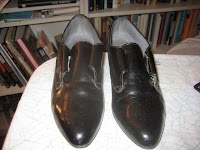So this weekend it was the largest annual event in Sweden, and one of the largest in the Nordic Garrison's/Base's troops. It was the
Scandinavian Science Fiction, Games and Film convention in Stockholm. This year there were more than 50 troopers from the Nordic Base and Garrison, as well as our friends from the Russian Outposts (both Rebel Legion and 501st). It's definitely so that our stand is one of the main attractions of the conventions. Usually there is a photoshoot opportunity, with Star Wars characters, and a the chance to shoot stormtroopers with nerfguns, blast-a-trooper. This year we were bigger than ever so we had two photo backdrops. One with a death star corridor, where you could get photographed with the Nordic Garrison and one with the Endor bunker, where you had the Nordic Base.
Costumewise I had decided to use my Amidala Purple travel gown. I love that costume, it's impressive, and I also realized that I hadn't trooped it at a major event. Then I also wanted to premiere my jawa. Well then I heard the news that we were going to have the Endor backdrop, and that we would have members costume as Return of the Jedi Han, Chewie and Luke, so I felt that I really had to bring Endor Leia as well.
The thing is though that I got scheduled quite a lot to be in the photostand with my Amidala, since it's a face character and people usually want to have photos with face characters. On Saturday I realised that it simply was impossible to change quickly between Amidala and Leia, due to the fact that Leia's hair takes a good 30-40 minutes to get right.
So here's the costume breakdown.
 |
| Mara Jade, R2D2 and Queen Amidala |
I wore Amidala on Saturday morning and almost all of Sunday. Most reactions I get is "look at the pretty princess", but that's ok. The costume is a bit hard to pose in fun ways, after all it's a regal and sombre costume so I'm mostly just tsnding there. It's starting to show that it's almost two years old, and even if I haven't worn it a lot I should make an overhaul of it. There are a bunch of small things that needs fixing.
One thing I did this time was to add two of my 18th century petticoats, and what a difference those made. With just one ruffled petticoat there has been a tendency for the hoops to show through and to have the outer skirt stick on to the hoop skirt. With two simple petticoats and a ruffled petticoat I had the best silhouette and behaviour of the dress that I have ever had. I also need to do something about my hairpiece. It's set on to a hard plastic alice band, and it presses on the sides of the my head and gives me headache. I'm thinking about doing two individual hair "buns" that I can clip on to the top of my head and get rid of the alice band.
 |
| Endor Leia and ewoks |
Endor LEia is one of my favorite costume, since it's so comfortable, and you can act out a lot more than with Amidala. The tricky thing is the hair, and I was lucky to get help to fix the hair, wich meant that I didn't get neckpains, since I have a tendency to pin the braided buns on too low. I need to redo the closure of the shirt, like many busty girls I have a bit of a problem with gaping and I fix it with safety pins, but it would be nice to have something more permanent. The boots are in for a replacement, they have started to burst, but an alternative would simply be to cover some cracks with black paint.
I also had to take care of the ewoks in this costume. One is a doll, but the other is a a child of our Finnish members, and when we had a parade the ewok could go in it if I looked after it.
 |
| this jawa found a broken droid |
The third and final costume was my jawa. I didn't have time to wear it for any official things, but in the last hour of the con, both on Saturday and Sunday, I could slip into it and just run around on the con floor. I can hardly see in it, but I can orientate myself, and the hood has three layers and is pretty hot, but the robe and shoes are really comfortable. Now with the convention being held at the start of the holiday season I also decided to do a gingerbread jawa. I simply pinned some white strips and roundels of white fabric on to it and ran around handing out gingerbreadcookies
 |
| and this jawa handed out cookies |
































.jpg)










.jpg)




